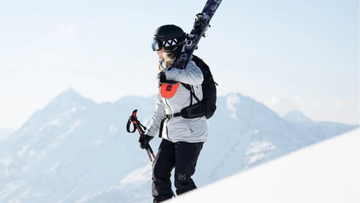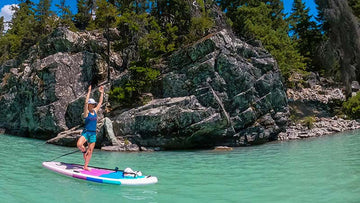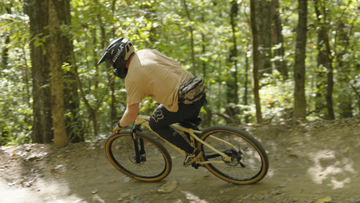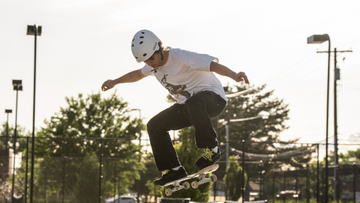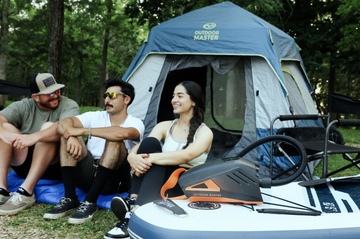SUP 101: Tips and Tricks for Beginners AND Experts
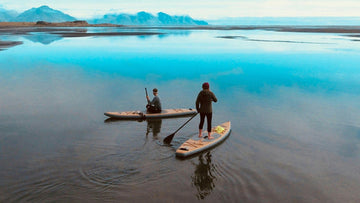
Welcome beginner and expert paddle boarders! Whether you have never paddle boarded in your life or you have done it a thousand times, it’s always helpful to brush up on your SUP knowledge.
Paddle boarding is challenging, especially if you are doing it for the first time or trying to learn a new technique/trick. Luckily for you, there are always new ways to paddle, waves to ride, and waters to explore. The first thing to check off your list is gear. Once you are geared up, you’ll be ready to paddle!
Note: Expert paddle boarders are encouraged to skip to the halfway point of this article ;)
Essential Gear Items to Complete Your SUP Experience

Before you hit the water or the waves, you must be geared up for the occasion. Oftentimes, all you need is your board and a paddle, but if you plan on taking your SUP to different spots or attempting more difficult waters, it’s always good to be well-prepared.
Board and Paddle
It should go without saying that you need a board and a paddle in order to paddle board. That said, if you are a total beginner, it might be a good idea to buy a used SUP or one that is better designed for beginners. Many of the more advanced paddle boards are heavy, technical, and difficult to steer. Likewise, there are many paddles to choose from; if you are a first-time paddle boarder, buy a paddle that you can learn on before upgrading to something more advanced.
iSUP Pump
Inflatable paddle boards are becoming commonplace within the paddle boarding realm, but there is one caveat to owning an iSUP: they are difficult to inflate! Most people can use a hand pump to blow up their inflatable paddle boards, but the time it takes to do so is not worth it, especially if you plan on going for a quick and easy paddle. Without an iSUP pump, inflating your paddle boards can take up to 30 minutes at a time. Not to mention, it leaves your arms and forearms tired and deflated (pun intended).
An iSUP pump ensures your paddle boards are inflated quickly and to the desired PSI. The Outdoor Master Shark II can pump up to four iSUPs in a row, each one taking only a matter of minutes. Not only will this save you time, but it will also save your energy for what you truly want to use it on, paddle boarding!
SUP Essential Accessories
Sunscreen – Unless you plan on wearing a long-sleeve shirt while paddle boarding, it is a good idea to apply lots of sunscreen before and during your paddle boarding excursions.
Waterproof Clothes Clothes – When paddle boarding, get ready to get at least a little when. It’s always a good idea to wear waterproof clothing, such as a swimsuit or swim shoes.
Waterproof Storage – A waterproof bag, such as the Outdoor Master Dry Bag, is a perfect way to keep your valuables (wallet, phones, keys) nice and dry.
Straps or Bungee Cords – If you have a traditional SUP, then owning some straps to put the SUP on top of your car is essential. If you own an inflatable SUP, you’ll never have to worry about that!
6 Tips to Becoming a Master Paddle Boarder:

Map Your Journey
Before going on your first paddle boarding excursion, it might be a good idea to plan where you are going before you go. You can do this by using Apple Maps or Google Maps to map out where it is you will be paddling. Even just a little planning can go a long way, especially if you ever get lost.
Check the Forecast
Checking the weather app before going out never hurts. If you live somewhere with tropical weather storms, such as Florida, checking for bad weather is vital for your safety. There is nothing worse than being a few miles offshore caught in a storm.
Start on Your Knees
Standing up on your paddle board is difficult. Learning the correct balance technique takes time and practice. If the waves are high or you are constantly falling, try paddling on your knees until you feel confident to get on your feet.
Always Wear Your Leash
It might seem silly to always wear your leash, but it is the #1 way to make sure you and your paddle stay together. If you plan on SUP surfing or paddle boarding in rivers, a leash is a must. You do not want to lose your board to a wave or to the tide, especially if you are in deep waters.
Learn to Fall Well
Everyone falls, even the pros. It’s important to learn to fall the right way, though. A paddle board is still a heavy, solid object, and can do some damage if you fall on it or if it strikes you. No matter what kind of paddle boarding you are doing, you’ll always want to fall away from your board.
Use Your Core and Keep Your Head Up
Balancing on a paddle board can be difficult, but you’ll only make things harder if you constantly look down at your board. To keep better balance, keep your eyes locked on the horizon and bend your legs. When paddling, it’s imperative to make use of your core muscles. Without using your core, you’ll tire out your arms.
How Does One Improve Their SUP Skills?
Getting better as a paddle boarder takes time, so be patient. That said, you can improve your paddle boarding skills by testing and pushing your abilities to their limit. You can do so by riding larger waves, taking longer trips, and practicing in more difficult waters.
Once you’ve mastered the basics, it’s time to identify which type of paddle boarding is right for you.
The Different Types of SUPs and Paddles

Much like skiing and snowboarding, there are different types of paddle boarding, and not just the difference between traditional vs. inflatable paddle boards.
All-Around Paddle Boards
Commonly referred to as ‘flat water paddle boards,’ all-around SUPs are exactly what they sound like. This type of paddle board is the most versatile of them all and arguably the easiest to use. These paddle boards are perfect for lakes, rivers, and calm ocean bays. They are typically longer than 10 feet long and substantially wide for enhanced balance. Many people enjoy doing SUP yoga on these types of paddle boards.
Surf Paddle Boards
Also known as ‘performance paddle board,’ this type of SUP is primarily used for surfing and shorter, more intense rides. You won’t typically see this type of SUP lazily gliding along a calm lake. These boards can be as short as 7 feet long and typically have a pointed nose. They are less wide and most certainly designed for more seasoned paddle boarders.
Touring/Racing Paddle Boards
This type of SUP is long and streamlined, kind of like a canoe. They are often made with a lightweight material such as fiberglass. This makes them lighter and easier to cut through the surface of the water. This type of SUP can be hard to balance on and control, but, once mastered, is great for long hard rides.
How to Enrich Your Paddle Boarding Experience?

There are many ways to enrich your paddle boarding experience. The most obvious is to share your love of paddle boarding with those around you. Plan trips, paddle through new waters, and don’t be afraid to bring others who have never used a SUP in their life.
Depending on where you live, you might be in an area that has one or more paddle board leagues. These leagues include races, events, and casual get-togethers to enjoy paddle boarding as a group.
Last but not least, you can enrich your paddle boarding experience by pushing your limits and getting better as a paddle board user. Owning an SUP is fun, but how much you improve on it is up to you.
Last Thoughts
Here at Outdoor Master, we take pride in helping others do what they believe. If you are a beginner paddle boarder, make sure you gear up well, learn the basics, and have tons of fun. If you are a more advanced rider, consider leveling up by identifying a type of paddle boarding that you could pursue, whether that be all-around, surfing, or touring.
Make sure to follow us on TikTok and Instagram and always #DoWhatYouBelieve!


